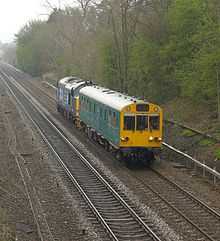975025 Caroline

975025 Caroline, originally the Southern Region General Manager's Saloon, is an inspection saloon used for rail inspection duties on the railway network in Great Britain,[1] and which has historically been used as a VIP excursion train on several occasions.
The saloon carriage is notable for being used as the British Royal Train between London Waterloo and Romsey[2] for the first part of the honeymoon trip following the wedding of Charles, Prince of Wales, and Lady Diana Spencer on 29 July 1981.[1][3][4] One year later on 28 May 1982 Caroline was the transport for Pope John Paul II's visit to the United Kingdom between Gatwick Airport and London Victoria station.[5] Additionally Caroline formed the first standard gauge passenger service into the Channel Tunnel on 22 October 1992, leaving from Waterloo International railway station and propelled by 73112 University of Kent into the tunnel.[5][6] The passengers on the journey were those from the Parliamentary All-Party Channel Tunnel Group.[6] The train left Waterloo International at 10:10, and ran to Clapham Junction where it reversed and ran to Orpington and on to Ashford International for access to Dollands Moor Freight Yard.[6] The Channel Tunnel was entered at 13:00.[6] On 18 March 1996 Caroline and 33109 travelled to Chesham tube station on the London Underground network as part of suitability investigations for the Crossrail project.[7]
History
The vehicle was originally built in 1958 at Eastleigh Works as type AZA trailer restaurant buffet car (TRB) S60755, for a British Rail Class 203 diesel-electric multiple-unit No. 1036,[3][8] until withdrawal during 1964.[9] These "Hastings Units" had a narrow body profile for working through tunnels on the Hastings Line, and is the reason for the continued narrow width of Caroline.
Modern use
As of 2012 the saloon has had push–pull train controls similar to a driving van trailer for a period of several decades, to allow it to remotely control an accompanying locomotive. It was previously the Southern Region General Manager's Saloon,[10] having been converted at Stewarts Lane Depot for that purpose in 1969[11] and re-numbered as 975025 in 1978.[12][13] For this, Caroline was fitted with Southern Region-style multiple working controls allowing usage with British Rail Class 33 and 73 diesel locomotives, and other Class 400 EMUs. By 1991 it could be seen in Network South East livery.[8]
In 1999, Caroline was overhauled by Fragonset Railways at the Railway Technical Centre in Derby and transferred to Network Rail,[13] subsequently being frequently operated by Victa Westlink Rail. Modifications in the late 2000s converted Caroline to require an electric train heating (ETH) supply and use the "blue star" multiple working system.[14][15][16] After this conversion it was normally propelled by a Class 37 diesel locomotive.[17] The inside of the cab states that Caroline has a maximum speed of 100 miles per hour (160 km/h).[18]
Preservation and heritage
On 12 December 2008 Caroline was "designated for preservation" following a vote by the Railway Heritage Committee, after earlier consideration by the Artefacts Sub-committee concluded that the case for designation was 'marginal'.[4]
References
- ↑ 1.0 1.1 Newby, Howard; Railway Heritage Committee (12 October 2009). Artefacts Sub-committee. Annual Report 2008–2009 (Report): 7,9. Retrieved 21 June 2012.
- ↑ Bannister, Andrew, ed. (10 November 2010). "Royal Train Workings: A Review". Derby Sulzers. Retrieved 21 June 2012.
- ↑ 3.0 3.1 Railway Heritage Committee (13 March 2009). "Designation of 'Caroline' - 12.12.08". News. Department for Transport. Retrieved 21 June 2012.
- ↑ 4.0 4.1 Faulkner, Richard; Austin, Chris; Brown, David; Gough, John; Jones, Gareth; Lamport, Mike; Newby, Howard; Ovenstone, Peter; Wilson, Catherine. Butters, Neil, ed. "RHC 08/106 Designation: 'Caroline' – DB 975025". Minutes of the Sixty-Second Meeting of The Railway Heritage Committee held 12th December 2008 at Fielden House, 13 Little College Street, Westminster. Department for Transport. pp. 3–4. Archived from the original on 10 April 2013.
- ↑ 5.0 5.1 "The history of our "Hastings" DEMUs". Hastings Diesels Limited. 12 December 2011. Retrieved 21 June 2012.
- ↑ 6.0 6.1 6.2 6.3 Lord Mountevans (11 November 1992). Brown, Murray, ed. "First Channel Tunnel passenger train". RAIL (magazine) (187): 8–9. ISSN 0953-4563.
- ↑ Greenaway, Bob (1996). "Photographs". Underground News (London: London Underground Railway Society): 346, cover. Retrieved 26 June 2012.
- ↑ 8.0 8.1 "975025 - In Profile". 33103.com. 27 July 2006. Retrieved 21 June 2012.
- ↑ Glasspool, David (30 March 2011). "Class 201/202/203 Hastings 6S; 6L; 6B". Kent Rail. Retrieved 21 June 2012.
- ↑ Lewis, John; Duff, Colin (28 April 2012). "Rolling Stock Directory". Southern Electric Group website. Retrieved 21 June 2012.
- ↑ "Inspection Coach". M.A.R.C Models. 25 May 2012. Retrieved 21 June 2012.
- ↑ Burkin, Nigel (29 June 2011). "A touch of Southern flavour". Nigel's Mountains and Modelling.
- ↑ 13.0 13.1 Heys, David (10 August 2012). "Caroline". Along Winwick Lines. Retrieved 21 June 2012.
- ↑ Tunstall, Ian (27 April 2010). "Caroline Inspection Saloon" (photograph description). Tunnys Pics. Flickr. Retrieved 26 June 2012.
- ↑ Hydro (20 June 2012). "Another random one on Settle-Carlisle" (forum reply). Tours & Special Workings. RailUK Forums. Retrieved 26 June 2012.
- ↑ SD0853 (8 February 2009). "975025 - Inspection saloon" (reply). Departmentals website. Retrieved 26 June 2012.
- ↑ Growler (23 June 2011). "A top and tail multiple working question" (forum reply). The Messroom. p. 2. Retrieved 26 June 2012.
- ↑ Morrison, Brian (15 January 2007). "From a different viewpoint…" (interior photograph; no.2 cab end). Railway Photography (The Railway Centre) (10): 18. Retrieved 28 June 2012.
External links
-
 Media related to 975025 Caroline at Wikimedia Commons
Media related to 975025 Caroline at Wikimedia Commons
| ||||||||||||||||||||||